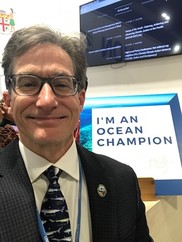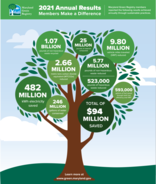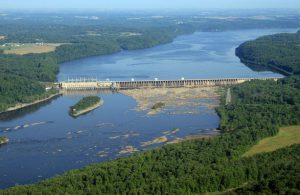|
THE OCEAN WITHIN US
June is World Oceans Month, a time to commemorate and rededicate to protecting the deep and salty blue that covers 70% of the earth’s surface.
Rachel Carson’s "The Sea Around Us" (1951) had a big impact on me when I read it for the first time in 1993. This timeless, well-documented weave of science and poetry about our oceans and coasts can inspire all, including laymen and landlubbers, to see the wonder, mystery, and fragility of our marine waters. It was a handy resource as I worked as a young staffer on Congressional committees in the 1990s on writing and overseeing landmark laws and programs such as the Clean Water Act, the Oil Pollution Act, the Marine Protection, Research, and Sanctuaries Act, the Great Lakes Initiative, Water Resources Development Acts, the National Invasive Species Act, medical waste and plastic pollution prevention laws, and implementation of the Chesapeake Bay and Maryland Coastal Bays programs and the broader National Estuaries Program.
Rachel Carson’s "The Sea Around Us" doesn’t get quite as much attention as her other masterpiece, "Silent Spring," but it sets a perfect framework for education, conservation, restoration, and rescue missions underway or about to be launched for our marine world.
I’m not the first person to glean from her book the clear message that the sea around us is also within us. Just Google “ocean within us” to confirm. The watery mix of salts and other minerals found in the ocean similarly flows through our veins. The chemical, physical, and biological integrity of the oceans will continue to determine the health, happiness, and prosperity of our communities locally and globally.
I’m proud of the work Maryland does to protect our ocean and coastal waters and sustain the living resources and economies that depend on our greatest liquid asset. The Hogan Administration, including agencies such as MDE and the Maryland Department of Natural Resources, and universities such as the University of Maryland Center for Environmental Science, continue to set strong examples for other states on education, conservation, restoration, and protection of the ocean and coastal waters around us. I am particularly proud of the work we’re doing on climate change, including coastal resiliency and smart growth, living shorelines, and blue carbon. Our state’s work on reducing plastic pollution gets national attention as well, as does our leadership on offshore wind, including the Governor’s joining with North Carolina and Virginia on SMART-POWER, a bipartisan pact to advance regional offshore wind energy.
 |
|
In 2019, on behalf of the Governor, I attended the 2019 Global Climate Summit, (also known as Council of Parties, COP 25) in Madrid, which became known as the Blue COP because of its increasing focus on the oceans. In close coordination with Secretary Jeannie Haddaway-Riccio of the Department of Natural Resources, I signed onto an ocean acidification action plan with three other states and in partnership with the ocean conservancy and other environmental organizations. It emphasized scientific research and education, reduction of greenhouse gas emissions and vessel and land-based sources of pollution, and collaboration among all sectors. It was a significant and bipartisan step for climate action at a time when the executive branch of the federal government was backing away from the Paris climate accord and the science surrounding climate change. |
Capitol Hill Oceans Week (June 6-10) just concluded a successful series of briefings and discussions to foster environmental progress, with a particular focus on equity and justice. One of the key partners was the National Marine Sanctuary Foundation. Also, earlier in the week there were celebrations and websites celebrating the cause.
Give our oceans a big and respectful hug in whatever way you can, whether it’s reducing your carbon and single-use plastic footprint, supporting marine science and literacy, championing stewardship of living resources and climate-ready communities, or, in the spirit of the late great Rachel Carson, a resident of Silver Spring, Maryland, for much of her research and writing, connecting the dots and drops for future leaders to never lose sight of the wondrous sea around us and within us.
• Air, Land, Water - Did You Know?
Maryland Green Registry awards

Lt. Governor Boyd Rutherford and Maryland Department of the Environment Secretary Ben Grumbles announced the annual Maryland Green Registry Sustainability Leadership Awards and environmental results. Those results showed continued gains in reducing pollution, along with nearly $94 million in cost savings through environmental practices. Winners were chosen based on their commitment to continuous improvement and environmental results achieved through sustainable practices.
|
The Leadership Award winners are:
Baltimore Community ToolBank
Chesapeake Bay Roasting Company
Frederick County Government
University of Maryland, Baltimore County
West Nottingham Academy
A video of the awards event, featuring submissions from all the award winners, can be found on the Maryland Green Registry website.
Board of Public Works approves funding for Ellicott City climate resiliency and the Chesapeake Bay
The Maryland Board of Public Works approved a $2.4 million grant to better control stormwater runoff and help protect Ellicott City from flooding.
A $2,446,309 Comprehensive Flood Management Grant to Howard County will help fund the construction of a stormwater detention basin to provide flood protection for downtown Ellicott City. The new dry pond at the cloverleaf area at the intersection of U.S. routes 40 and 29 will reduce the flows to the Hudson Branch, which passes through downtown Ellicott City. This project is consistent with Maryland’s climate change adaptation and resiliency objectives through the reduction of runoff that is exacerbated by increased precipitation or flooding events.
“This investment represents a big step in helping to keep downtown Ellicott City from experiencing the catastrophic flooding it has seen in recent years,” said Maryland Environment Secretary Ben Grumbles. “With climate change bringing wilder and wetter weather, it is more important than ever to support water infrastructure improvements to make Ellicott City and other Maryland communities safer and more resilient.”
MDE announces stormwater enforcement settlement with Prince George’s County
The Maryland Department of the Environment announced an agreement with Prince George’s County to resolve violations of the county’s municipal stormwater permit.
The agreement, outlined in a consent decree filed in Prince George’s County Circuit Court, imposes a $475,000 penalty for the failure to complete all of the stormwater runoff reduction work required by the National Pollutant Discharge Elimination System (NPDES) Municipal Separate Storm Sewer System (MS4) permit issued by MDE to the county in 2014. The penalty can be satisfied through the construction of one or more MDE-approved supplemental environmental projects by December 31, 2024.
The consent decree also requires timely completion of stormwater work still remaining under the 2014 MS4 permit. The settlement calls for additional penalties for failure to meet progress milestones.
“This enforcement action reflects the state’s priority on preventing stormwater pollution and growing green infrastructure for clean water and climate resilience throughout the Chesapeake Bay,” said Maryland Environment Secretary Ben Grumbles. “We appreciate Prince George’s County for stepping up to improve environmental performance under its permit and agreeing to an enforcement decree, including penalties, schedules, and supplemental environmental projects.”

Maryland has received the first payments, totaling more than $5.7 million, under an agreement that requires the owner of the Conowingo Dam to invest in environmental projects and operational enhancements to improve water quality in the Lower Susquehanna River and the Chesapeake Bay.
Conowingo Dam owner Exelon Generation Company, LLC, made payments to the Maryland Department of the Environment (MDE) and the Maryland Department of Natural Resources (DNR) to allow for the start of a series of projects that will play a key role in Maryland’s holistic strategy to improve water quality and accelerate the restoration of the Chesapeake Bay. The agreement requires a total of more than $200 million in investments by Exelon, including nearly $107 million in payments to Maryland, over the 50-year term of its recently renewed federal license.
“After nearly a decade of gridlock, the funds and actions for clean water and climate action at the Conowingo Dam are finally beginning to flow to the benefit of the state and the Chesapeake Bay,” said Maryland Environment Secretary Ben Grumbles. “We have a hard-fought and fully-enforceable commitment by the dam owner now in place under federal and state law, but we know more action is needed throughout the watershed. This is why we’re taking a holistic approach, working with states and the federal government to increase climate resiliency and prevent pollution far upstream and directly behind the dam. We’re also committed to working with citizens and stakeholders on the best ways to prioritize and maximize the benefits of this work for years to come.”
|
• In the News
Hagerstown Herald-Mail: MD environment secretary emphasizes state’s ambitious greenhouse gas reduction plan
In the wake of President Joe Biden announcing his commitment to cut national fossil fuel emissions up to 52% by 2030, Maryland Environment Secretary Ben Grumbles emphasized Maryland’s already ambitious plan to reduce greenhouse gases.
Go to the story
• Have an Idea?

Email the editor
We're always looking for ideas to make eMDE even better. Here's a chance to tell us what you think. Have some thoughts on what we can do better or things you'd like to see more of?An idea for a specific story? We want to hear from you. Contact us!
|
|